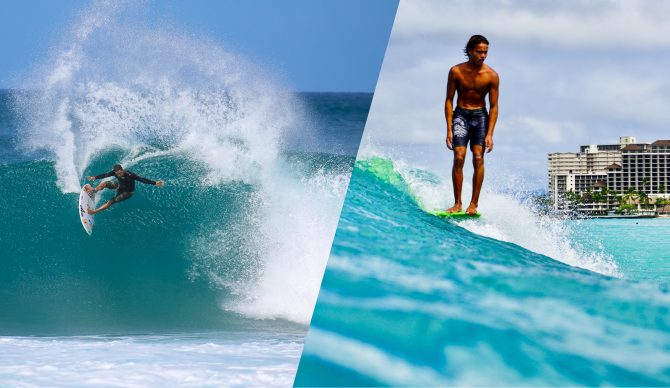
Longboarding and shortboarding breed entirely different approaches to surfing, creating an unending debate. Images: Brent Storm and Knut Robinson//Unsplash.
The feud between longboarders and shortboarders is as old as time (well, technically since at least the shortboard revolution). This long-standing debate has often forced people to choose a side as either a longboarder or a shortboarder and defend their title.
We’re all doing essentially the same thing: riding waves and enjoying the ocean. But an extra three to four feet of foam makes all the difference. It breeds entirely different styles, cultures, and mindsets with regards to surfing. Surf spots are strictly categorized as longboard waves or shortboard waves; don’t you dare paddle out to Lowers on a longboard and don’t you dare take out your thruster at Old Man’s.
On a small summer day my friend and I were riding longboards at our local spot when a middle-aged man paddled up and snapped at us, “All you kids these days just want that instant gratification with riding longboards! You should have to work harder!”
With surfers labeled as either “shortboarders” or “longboarders” come preconceived assumptions about the other. Shortboarders roll their eyes at the longboarders that sit out the back and hog all the waves. They think longboarding is too easy or isn’t real surfing. Conversely, longboarders think shortboarders take surfing too seriously, with too much aggression, and walk around with an air of superiority.
There’s nothing wrong with the differences between longboarding and shortboarding, they simply produce two different approaches to surfing. The nature of shortboarding evokes a more competitive, performance-based (see progressive) style of surfing, whereas longboarding typically breeds a laid back and relaxed culture.
The incessant, deep-rooted feud between longboarders and shortboarders emerges even in competitive surfing, and it’s clear that competitive surfing’s favorite child is shortboarding. After nearly a year-long hiatus of competitive surfing due to COVID-19, the World Surf League was eager to bring back the Championship Tour and even Qualifying Series events. As far as professional longboarding, The WSL has tentative plans to resume the men and women’s longboard tour in September.
It’s only natural for competitive surfing to gravitate toward shortboarding. Good shortboarding looks difficult and impressive, whereas good longboarding looks effortless and easy. The fact is, shortboarding is more lucrative. There are more contests, opportunities, sponsorships, and audience engagement in shortboarding. Longboarders don’t mind that they’re mostly kept separate from surfing’s mainstream corporate commercialization. They’re too busy being anti-establishment, counterculture, Malibu-worshiping hipsters.
Perhaps our differences are too irreconcilable to mend? However, at the end of the day we’re all just trying to enjoy the ocean and catch some waves. The truth is there’s no right way to ride a wave. The need to categorize surfers as longboarders or shortboarders only creates division and discourages us to switch up board choice. Ultimately, the dynamic nature of surfing — the infinite possibilities of boards to ride and different types of waves — is what makes it so life altering. That’s why in my view, it’s so important to remember that by changing up your equipment once in a while, you’ll become a better, more well-rounded surfer. And maybe even a better human.

